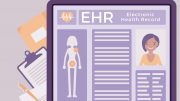The COVID-19 pandemic hasn’t been just a lesson in rapidly evolving health protocols — it’s also taught us a great deal about our need to continuously evolve our administrative protocols.
Research shows that, in the United States, approximately one in five patients have had trouble accessing telehealth tools, and the same number of patients has also struggled to locate important insurance information on their healthcare provider’s website. While this is a difficult number to swallow outside of the current situation, the challenges of scheduling appointments for critical care and follow up visits for long-haul COVID patients, makes these numbers even more concerning.
So how do we help patients have an easier and more reliable healthcare experience? Eliminating paper-based processes is the key. For a simpler and more accessible patient experience, we must set sights on centralising and digitising data.
Reliable access to healthcare starts with simplifying data
Many challenges in healthcare stem from outdated administrative systems and processes. Pre-pandemic, a lot of improvement projects were put on the back burner. Eliminating paper processes was certainly among them. But the past 18 months have dramatically accelerated the industry’s trajectory toward telemedicine and remote care. Failing to make improvements now can mean many of your patients won’t receive the quality of care and service they should.
For those new to the journey or at an inflection point, it can be difficult to know where to focus your efforts to improve the patient experience. But if you’re like many healthcare organisations wanting to improve scheduling, centralize accurate information and consolidate the digital patient experience, consider setting your sites on these goals:
-
Stop the flow of paper into your healthcare organisation
Up-to-date and accurate patient information has been life-saving during the pandemic. With full ICUs and flooded inboxes during spikes in cases, having comprehensive information about a patient’s health history, medications and current conditions has helped healthcare providers triage and treat patients. Of course, this data doesn’t just auto-populate into EPIC or similar systems. Instead, it often flows into various healthcare provider’s organisations on paper.
Committing to eliminating the flow of paper in and digitizing everything immediately not only benefits your organisation but healthcare as a whole. Eliminating paper is the first step toward centralising all patient data and creating a more comprehensive patient portal. Don’t wait for regulations or competitors to catch up — if you don’t have a plan to eliminate the faxes, forms and other manual workarounds that keep you from being completely digital, you’re going to be left behind.
-
Stem the flow of paper out of your organisation
Many patients who struggle to make appointments or find information are confused simply because they aren’t used to a digital experience. It’s not entirely their fault. Years of reliance on paper-based processes has gotten them used to receiving bills, appointment reminders and other important communications in the mail. With the right set of tools, however, you can design a paperless patient experience that is still intuitive for patients.
Healthcare leaders are often surprised by how much can change when you simply turn off the “print” button to internal staff which ensures following the digital process rather than crafting “paper” work arounds. — especially when they see how much time it gives administrators back to help patients in other ways. It has also revolutionized healthcare collaboration. When patients can easily share access to records and medical images to multiple providers, it allows them to receive care in a more streamlined manner.
-
Integrate modern processes in-office
Improving the digital patient experience doesn’t stop once they enter your door. Every piece of information the patient needs for their visit should be accessible to them beforehand — from a mobile app or through a browser— and a recap of their care should be immediately ready after the appointment. Additional considerations like check-in processes via mobile phone and payments that can be made via app are also becoming a standard patient expectation.
Patients make better and more informed decisions when all their information is in one place. Particularly during a pandemic, we know that this can save lives and improve outcomes. By committing to eliminating paper in, out and around our administrative processes, we’re building the digital infrastructure that will benefit providers, patients and physicians for decades to come.
By Colleen Sirhal, chief clinical officer and customer success leader at Hyland





